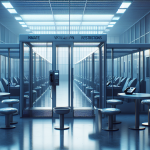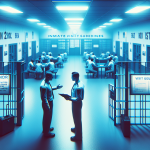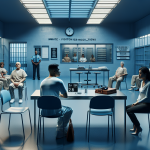Centralia Correctional Center – Overview and Information
Centralia Correctional Center is a maximum security prison located in Centralia, Illinois. It is operated by the Illinois Department of Corrections and currently houses approximately 1,500 male inmates. The center is divided into several units, including general population, segregation, and special needs.
General population units are for inmates who do not need to be separated from the general population. Segregation units are for inmates who need to be separated for safety reasons or who have exhibited behavioral issues. Special needs units are for inmates who need extra attention due to medical or mental health issues.
The facility is home to a variety of educational and vocational programs, such as GED classes, automotive courses, horticulture classes, plumbing and carpentry courses, and welding classes. These programs help inmates develop trades that will help them gain employment after they are released.
Inmates are required to participate in prison activities such as recreation, religious services, and other self-improvement programs. They may also participate in voluntary activities, such as the Peer Education, Parent Orientation, and the Recovery Program.
The center provides health and mental health services, which include physical and behavioral health assessments, individual and group therapy, and medication management. It also offers sex offender treatment, alcohol and drug programs, and diagnostic assessments.
The prison is monitored by a variety of security personnel to ensure the safety and security of the inmates and the facility. In addition, the Centralia Correctional Center has a 24-hour emergency response team to offer assistance in emergency situations.
Inmates are expected to follow the prison’s rules and regulations in order to remain at the facility. Violation of these rules and regulations may result in punishment through the prison disciplinary system.
Overall, Centralia Correctional Center provides a safe and secure environment for inmates while they complete their sentences. In addition, the educational and vocational programs, as well as mental health and medical services, help inmates prepare for their re-entry into society.
Centralia Correctional Center – Classes, Services, and Programs
Centralia Correctional Center is located in Centralia, Illinois and is part of the Illinois Department of Corrections. It houses both minimum and medium security inmates. The facility offers a variety of classes, services, and programs for both adult and juvenile offenders.
Education services at Centralia Correctional Center include GED programs, college courses, adult basic education, and vocational training in areas such as carpentry and electrical work. Inmates are also encouraged to participate in book clubs, mentorships, and art classes as part of their rehabilitation.
Health services at the center are provided by staff medical professionals, as well as contracted providers. Mental health services such as counseling and group therapy are also available. Programs at Centralia Correctional Center include Alcoholics Anonymous, Narcotics Anonymous, anger management, and aggression control classes.
In addition to its educational and health programs, Centralia Correctional Center offers re-entry programs designed to help offenders transition back to society. These programs include job-readiness skills, job placement services, and job search assistance. Inmates can also participate in volunteer opportunities such as adoption preparation and reading programs.
Centralia Correctional Center is committed to providing inmates with the resources they need to succeed after their release. All programs and services are designed to help inmates build character and develop skills that will help them stay out of trouble once they re-enter society. The staff at the facility encourages inmates to take advantage of these opportunities so that they can become productive members of their community.
Inmate visiting application in Centralia Correctional Center
The visitation process and requirements for all visitors at Centralia Correctional Center can be found on the Washington State Department of Corrections’ Online Visiting Application website.
In order to request visitation, an approved visitor must first complete the nine-step online application process. This includes entering personal, contact, and security information. Visitors must also acknowledge and agree to the Visitor Misconduct or Rules & Regulations, note the visiting period they would like to request, and submit the completed form.
In order to be approved for visiting, visitors must meet certain criteria. A Profile Card is provided to ensure each individual successfully meets the criteria and meets other visiting requirements. Once approved, visitors are notified via email or mail. All visitors must present appropriate identification and must sign in using their approved Profile Card when entering the institution for visitation. Inmates are responsible for requesting visitation, and their request must be approved before visitors are allowed into the facility.
Centralia Correctional Center also requires that a visiting form be filled out in advance. The form includes questions about the current visiting rules, an acknowledgement of risk, and a list of items not allowed inside the facility. Filling out this form ahead of time is important so that visitation requests can proceed quickly and smoothly.
Visitation in Centralia Correctional Center can be conducted from 8am-6pm Tuesday through Friday. Visiting information can also be found by calling the institution directly or visiting their website. Visitors must follow all visiting rules or face possible restriction from visitation. It is important to be respectful and professional to ensure a safe and pleasant visit.
Centralia Correctional Center: Frequently Asked Questions and Answers
Centralia Correctional Center is a prison facility in Chicago, Illinois that provides both custody and treatment for inmates. It is overseen by the Illinois Department of Corrections (IDOC). It is important to understand the important questions and answers regarding the facility because it can provide vital information about inmates and their rights.
Q. How does someone get committed to Centralia Correctional Center?
A. Individuals who are convicted of a crime by a court of law are sentenced to a particular prison facility, such as Centralia Correctional Center. Depending on the crime and severity of the sentence, inmates may spend time in jail, state prison, or a combination of both.
Q. Who are the staff members at the Centralia Correctional Center?
A. Centralia Correctional Center is staffed by correctional officers, mental health professionals, counselors, and other support staff. This staff is responsible for providing a safe, humane, and productive environment for the inmates.
Q. What types of treatment programs are available at Centralia Correctional Center?
A. Centralia offers a variety of therapeutic treatment programs for inmates. Programs range from anger management, substance abuse, cognitive behavioral therapy, mental health, and vocational training. These programs are intended to provide inmates with the necessary skills to lead a law-abiding and productive lifestyle outside of the prison.
Q. Are there any visitation rights or communication policies for inmates at Centralia?
A. Inmates are allowed to receive visits from family members and close friends. Visits must be scheduled and approved by prison staff. Inmates may also communicate with family and friends through phone, mail, video conference, or in-person visits. Each inmate is allowed to have up to six visitors at one time.
Q. How can I contact an inmate at Centralia Correctional Center?
A. Inmates may be contacted through phone, mail, or in-person visit. If needing to send mail, the respective inmate’s name, ID number, and address of Centralia Correctional Center should be included. Inmate phone calls can only be received through restricted numbers.






